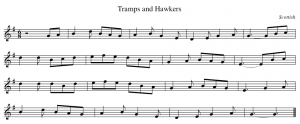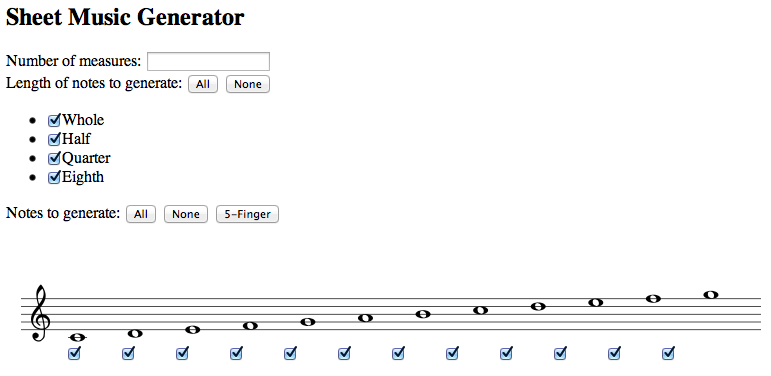One of the neat things about exploring a field you know little about is that you can learn a lot in a very short time. Last week I talked about LilyPond, a nice application for typesetting music. It’s a powerful program, capable of typesetting books of multipart orchestral scores. It works for me, and I like it. However, I’ve since learned that the world of folk music runs on a different music typesetting notation called ABC. ABC notation has been around for twenty years this month, and has been evolving throughout that time; and though I’d encountered it about ten years back I hadn’t realized how pervasive it had become.
How pervasive is that? I mentioned on a tin whistle forum that I was having trouble with fingering a particular part of a tune, and it was suggested that I include the ABC notation for that passage. A tin whistle player named Mary Bergin has recently published her own tin whistle tutorial; it includes both staff notation and ABC notation for all of the tunes. I’ve found a number of on-line archives of folk music tunes; most give the tunes in ABC format, usually with options to convert the ABC text to various print formats.
ABC notation is similar to LilyPond notation, but is much simpler. Here’s an example, for the same tune I showed in LilyPond format last week:
X:1
T:Tramps and Hawkers
C:Scottish
M:6/8
L:1/8
K:G
z4 GA | B2 d BAG | A2 B G2 E | D2 E G2 A | G3- GBc |
d2 d Bcd | efe dBA | G2 A BAG | E3- EBc |
d2 d dBd | efe dBA | G2 A BAG | E3 G2 A |
B2 d BAG | A2 B G2 E | D2 E G2 A | G3-G3 |]
The LilyPond output is somewhat prettier to my eye than the ABC output; but as you see below, it is certainly quite usable (click on it to see it full-size):
The beginning lines of the ABC code, i.e., the lines from from “X:” to “K:”, are the header: they identify the title, the time signature or meter (6/8), and the key (G Major), among other things:
X:1
T:Tramps and Hawkers
C:Scottish
M:6/8
L:1/8
K:G
The “L:” line is particularly interesting; it sets the default duration for the notes in the tune. In this case, the default note will be an eighth-note.
The header is followed immediately by the tune, with each line of text translated to one line of music. As with LilyPond, the measures are separated by vertical bars (“|”), but the notes and their durations are expressed differently. LilyPond uses a relative notation; ABC is absolute. In particular, the two octaves starting at middle C are denoted
C D E F G A B c d e f g a b c'
You can go one octave lower by appending a comma to the note name, and one octave higher by appending an apostrophe; but for the music I’ll be playing the two octaves shown here suffice.
Note durations are stated in terms of the default duration for the piece, eighth notes in this case. A note without a duration is an eighth note; a note with a duration of “2” is a quarter note; a note with a duration of “/2” is a sixteenth note.
The piece begins with this line:
z4 GA | B2 d BAG | A2 B G2 E | D2 E G2 A | G3- GBc |
The “z” denotes a rest; in this case, a half rest (4 eighth rests). It is followed by notes “G” and “A”, which are both eighth notes; and since “GA” are written with no white space between them they get “beamed” together. The same thing happens with “BAG” in the second measure. The last measure of the line contains two successive G notes, a dotted quarter note (3 times an eighth note) and an eighth note; and since they are separated by “-“, the two are tied together.
There are additional notations for slurs, sharps, flats, naturals, and so forth.
It’s a simple notation to read and use, and there are lots of tools available that make use of it. But more about that next week.












